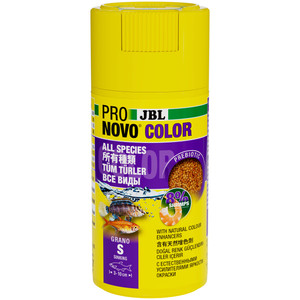
JBL PRONOVO Danio 100ml 48g XS Grano CLICK
JBLWrite a Review

JBL
JBL PRONOVO Danio 100ml 48g XS Grano CLICK
Description
- Prebiotic and sinking aquarium fish food: dedicated dietary fibres in the food supply the beneficial intestinal bacteria with food for healthy digestion
- Natural raw ingredients without artificial additives for a natural diet and healthy aquarium fish. Tested on JBL research expeditions in the tropics
- Very high acceptance even with choosy barbel species thanks to high-quality raw ingredients such as salmon, shrimps, spirulina and insects
- With the very high-quality natural astaxanthin from krill and spirulina, which ensures perfect colour formation in barbels & danionins
- Package contents: original sealed, air- and light-tight, recyclable tin with dosing lid as feeding aid or in freshlock bag
The biological species concept for ornamental fish:
In addition to a staple food such as JBL PRONOVO BEL for community aquariums, your fish can also be fed with foods from the JBL PRONOVO species concept. Within the species concept, you can add food specifically suitable for particular fish species or select alternatives for the main food. It’s no problem if, for example, your betta also eats the food for your barbels and vice versa. It is only important that you offer the right food for each group of fish. Variety is always a good thing!
Would you like to feed your barbels, danionins and others exactly the right food? No problem: in the JBL species concept you will find bite-sized granulates for barbels (and other small danionins) whose composition is precisely adapted to the needs of the fish, including insects: the JBL PRONOVO DANIO. In their natural habitats in Southeast Asia and Africa, barbels and danionins live in a wide variety of water types. With their small, terminal mouths, they “pick up” food from the water or from the bottom.
The right food size:
A very important aspect of correct feeding is the right food size for the mouth. It is especially important with small fish species that the animals get the food morsels into their mouths, as they cannot bite pieces off. If you are unsure of two food sizes, always choose the smaller one. Predatory fish species cope much better with larger food chunks, as “too large” food chunks are also included in their food spectrum.
Crude protein (39.0%)
Fat content (6.0%)
Crude fibre (4.0%)
Crude ash (8.0%)
Ingredients:
insect protein (Hermetia)
wheat meal
Salmon meal
rice meal
wheat germs
spiniach
shrimp meal
spriulina
yeast extract
soy bean meal
herbs




